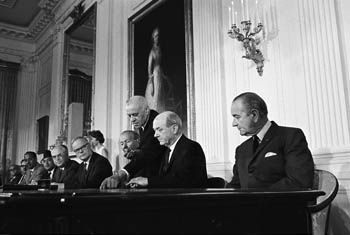In the Cold War era, the United States and the Soviet Union were locked in a cycle of escalating arms production following the development of nuclear weapons. This situation presents a classic prisoner's dilemma. The dominant strategy of either country was to increase stockpiles to maintain a position of deterrence, leading to a pareto-inefficient equilibrium that trapped both countries and heightened the risk of global nuclear annihilation.
There were two options for a pareto-efficient equilibrium: first, complete destruction of all nuclear weaponry; second, significant reduction of nuclear weaponry. As it is impossible to “close Pandora’s box,” the first option is unrealistic. However, the Nuclear Proliferation Treaty of 1968 represented a pareto-efficient move. It institutionalized an effort for disarmament and represents the situation in which all parties commit to contribute to the common good.

The issue with the NPT is its lack of a single, powerful enforcement mechanism. No “crazy cousin Jeff” will come to break the knees of a country that doesn’t contribute. This presents a secondary prisoner’s dilemma: to honor the treaty or defect. Smaller enforcement mechanisms such as the UN Security Council and diplomatic pressure exist, but compliance is never guaranteed.
No comments:
Post a Comment